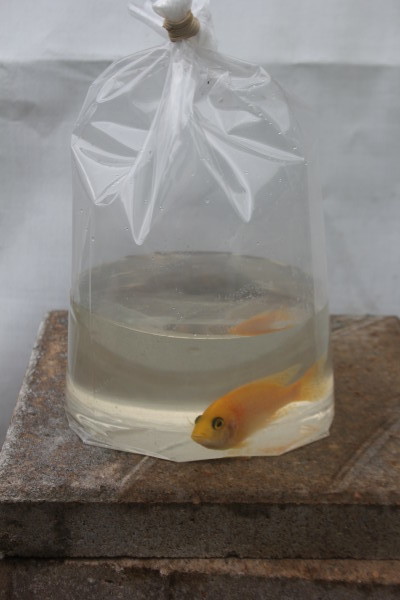Photo is a young male Dragon Blood Peacock Cichlid in a shipping bag.
Acclimation Recommendations
The principals of Goliad Farms, Inc., after decades of collecting, raising, shipping, transporting and importing tropical fish, have developed methods of acclimation tropical fish. Some of these techniques conflict with generally accepted practices, but are based upon direct experimental experience. These methods are presented below.
Acclimation is the process of adapting fish just received to the conditions in your aquarium. There is much written about this process; most of which Goliad Farms has found to be wrong and even damaging to the fish. Following are our acclimation recommendations:
1) First, immediately upon arrival, unpack the fish and inspect the bags. Each bag should be firm and the exterior dry. Fish are typically bagged with oxygen (about 1/3 water, 2/3 oxygen), although recently many, including us, have begun to ship with breathing bags which allow carbon dioxide and oxygen to diffuse through the plastic. Any bags that have deflated should be dealt with first. Be sure to inspect the bags out of sunlight. The closed bags act as miniature greenhouses and can overheat rapidly.
2) Next, inspect the fish. Record any losses by means of digital camera or cellphone. If you ordered from us and have ordered more than one species or variety, the bags will be labeled unless there is no chance of mis-identification.
3) The aquarium that the fish are to be introduced into should be clean with a well-established filter. Fish should always be placed in a quarantine aquarium for at least a week and treated in a prophylactic manner (this is discussed later). Never place the fish in an aquarium with other fish, always quarantine. Many of the nastiest diseases can remain dormant until a fish is stressed, then reproduce rapidly.
4) The next step deviates from the recommendations of most authorities. Open the bag. Test the water temperature by dipping a finger in the bag’s water and then into the aquarium into which the fish will go. Unless there is a significant difference in water temperatures, the fish can be transferred immediately. If you are not sure about your ability to test the water temperature, then use a thermometer. If the temperature difference does not exceed 5°C (9°F) either way, then the fish can be transferred without damage. Most authorities recommend floating the bag in the aquarium to equilibrate the temperature. This is unnecessary and merely stresses the fish more. The fish should be transferred quickly to reduce handling stress and the stress of remaining in the polluted water of the bag (the fish have been excreting into this water since they were packed!). In nature, the author has witnessed fish moving from cool pools into warmer open water at will with no ill effects. It is ludicrous to assume that fish cannot handle such routine temperature changes. Next time you can observe native livebearers and minnows at the edge of a pond or stream and watch the fish move from warm shallow water into the safety of much cooler, deeper water, check the temperatures of the edge water and the deeper water. These fish routinely move from the warm shallow water where they feed and are safe from aquatic predators to cool deep water where they are safe from terrestrial predators and wading birds. Even tropical waters have large temperature differentials between the shallows and deeper pools, often in the range of 10°C (18°F). In their natural habitats freshwater fish, especially those of the tropics and warm temperate areas, are adapted to such large, rapid temperature changes.
5) Remove the fish from the bags without introducing into your aquarium the water in which the fish were shipped. The water in the bag is contaminated by fish wastes and is not good for the fish. The author prefers to dip the fish out of the bag by hand (be sure your hands are clean and without soap or lotion residues!) instead of using a net that can abrade the fish. Be sure to do this while holding the bag over the aquarium in case the fish flips from your hand.
That is all there is, except for preventative treatment, which will be the subject of a blog very soon.


Christophe Lavenir says
Agree a 100% about temperature, but how do you deal with other parameter differences like ph and water hardness?
charles says
Christophe,
I’ve found that fish handle both pH and hardness changes as long as the changes are not outside their normal environmental tolerances. I’ve witnessed very sensitive fish moving repeatedly across the boundary between two streams with different pH and hardness values, but both within what that species can handle. In the case of shipping water, your water will almost certainly be better for the fish than the water in the bag. My policy is to get the fish into good water as soon as possible. Another factor to consider is that mixing water can often convert relatively benign ammonium salts into more toxic versions.
Charles
Tina says
does this apply to your cherry Shrimp too?
Charles Clapsaddle says
Tina, Yes, it does. I routinely move cherry shrimp between water that is more than ten degrees Fahrenheit different without issue. I’ve also moved them from our system water at pH 8.5 to pH 7.0 water without problems.
Charles
Vinnie says
You guys are simply amazing and you’re a national treasure in this industry.
Such humble and positive vibes from you both and Goliad. May God bless u with more success and amazing health.
Thank you for all this valuable information which makes so much sense now when you broke it down about the shallow water vs deeper cooler waters.
Stay blessed
Susie Clapsaddle says
Vinnie, I’m sorry for the tardy repl. Thank you. Charles